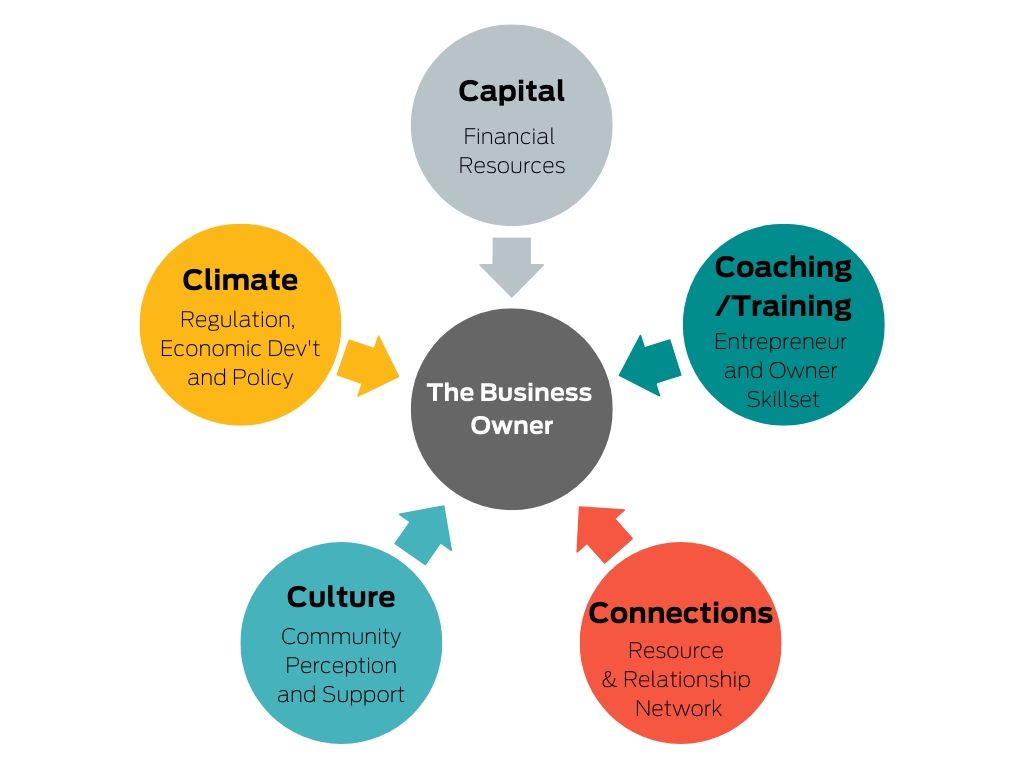Rural economies are particularly dependent on small business development and they need a supportive environment. Rural areas need to support their indigenous entrepreneurial resources with what these small businesses really need – a strong local entrepreneurial ecosystem with business training and management skills, small amounts of capital, access to markets, an environment in which to thrive, and policies that encourage entrepreneurship.
A shift is needed to move from old strategies that may have worked for a different economy to a new innovative, creative and flexible method that will work for today’s economy – strategies that are based on creating jobs locally and based on building a Local Entrepreneurial Ecosystem. This will create a strong and diversified infrastructure of many small, locally-owned businesses that will be a major source of job creation, economic stability, and community success in the new economic reality.
A Local Entrepreneurship Ecosystem is made up of the five ‘C’s: Coaching (all training), Capital, Connections, Climate, and Culture. When these pieces are in place, local economies can foster independents and micro-business owners and create a sustainable, self-reliant, and thriving local economy.

The first three C’s are internal to the entrepreneur or business owner.
Any successful business will have within its structure the following: skilled talent, financial capital, and connections to markets and networks. The way to develop the talent is to ensure some kind of coaching whether in the form of one-on-one mentoring and advising, business classes, workshops on specific topics, online learning, peer learning, or any type of business assistance. It is the first step in the capital access process. Eighty percent of business owners that receive help succeed and create two additional jobs within two years.
Every business needs some kind of capital whether it is used to develop a website and software, buy inventory, or do R&D. Small loans matter a lot. LiftFund did a five-year study and found that startups receiving funding are “dramatically more likely to survive, enjoy higher revenues and create more jobs” and that receiving a microloan can increase a business’s chance of surviving by over 50%.
A business can’t be successful if it doesn’t have clients, so connections are another important piece of the ecosystem. Connections include peer networks, online platforms, trade fairs, and other spaces where people network and gather, whether online or in a physical space. Peer networks include chambers and MeetUp groups. Examples of online platforms include: Etsy, eBay, Lyft, and the other gig working platforms. Trade fairs such as the Fancy Food Show by the National Specialty Food Association brings all types of food makers together with buyers. Other spaces that connect business owners with each other include maker spaces, business incubators, and co-working spaces. All are part of an entrepreneurial ecosystem.
The other two C’s – culture and climate – are external to the business owner and form the environment in which they work. Culture is the community perception and acceptance of entrepreneurship as a valid career path. When people support local businesses and the community understands the value of local businesses, they will have a stronger local entrepreneurial ecosystem. Climate includes regulation on all levels and policy – such as taxes, ease of the permit process, regulations that don’t conflict, and investments in business development.
Part of being in an ecosystem is that the pieces interact, support each other and depend upon each other. Much like a puzzle, our ecosystem needs each piece, each C in this case, to show the full picture and increase its impact.
“Connected economies have higher median incomes, lower-income volatility, more high-wage service jobs, lower median ages, higher population growth, and greater educational attainment than their isolated peers.”1
1“The Challenges and Opportunities of Running a Small Business in Rural America,” John Lettieri, Economic Innovation Group
